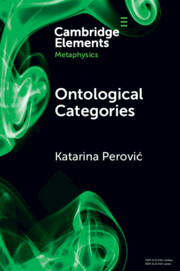48 results
Chapter 12 - Relative Concepts
-
-
- Book:
- Conceptualising Concepts in Greek Philosophy
- Published online:
- 25 April 2024
- Print publication:
- 02 May 2024, pp 285-306
-
- Chapter
- Export citation
Chapter 17 - Plotinus on Concepts
-
-
- Book:
- Conceptualising Concepts in Greek Philosophy
- Published online:
- 25 April 2024
- Print publication:
- 02 May 2024, pp 384-403
-
- Chapter
- Export citation
Chapter 19 - Early Christian Philosophers on Concepts
-
-
- Book:
- Conceptualising Concepts in Greek Philosophy
- Published online:
- 25 April 2024
- Print publication:
- 02 May 2024, pp 427-451
-
- Chapter
- Export citation

Ontological Categories
- A Methodological Guide
-
- Published online:
- 31 January 2024
- Print publication:
- 29 February 2024
-
- Element
- Export citation
Aquinas on The Distinction Between Esse and Esse: How the Name ‘Esse’ Can Signify Essence
-
- Journal:
- New Blackfriars / Volume 104 / Issue 1114 / November 2023
- Published online by Cambridge University Press:
- 01 January 2024, pp. 628-650
- Print publication:
- November 2023
-
- Article
- Export citation
Chapter 4 - The Metaphysical Deduction and Schematism
-
- Book:
- Heidegger's Interpretation of Kant
- Published online:
- 01 June 2023
- Print publication:
- 15 June 2023, pp 104-132
-
- Chapter
- Export citation
Chapter 6 - Transcendental Philosophy and the Critique of Pure Reason in the B-Deduction
- from Part III - The Method of the Critique of Pure Reason
-
- Book:
- Kant's <I>Critique of Pure Reason</I> and the Method of Metaphysics
- Published online:
- 11 May 2023
- Print publication:
- 25 May 2023, pp 194-206
-
- Chapter
- Export citation
Chapter 3 - Metaphysical Deductions
- from Part II - The Method of Transcendental Philosophy
-
- Book:
- Kant's <I>Critique of Pure Reason</I> and the Method of Metaphysics
- Published online:
- 11 May 2023
- Print publication:
- 25 May 2023, pp 75-121
-
- Chapter
- Export citation
Chapter 4 - Transcendental Deductions
- from Part II - The Method of Transcendental Philosophy
-
- Book:
- Kant's <I>Critique of Pure Reason</I> and the Method of Metaphysics
- Published online:
- 11 May 2023
- Print publication:
- 25 May 2023, pp 122-168
-
- Chapter
- Export citation
HERMODORUS OF SYRACUSE AND SEXTUS EMPIRICUS’ ‘PYTHAGOREANS’ ON CATEGORIES AND PRINCIPLES
-
- Journal:
- The Classical Quarterly / Volume 73 / Issue 1 / May 2023
- Published online by Cambridge University Press:
- 20 June 2023, pp. 368-382
- Print publication:
- May 2023
-
- Article
-
- You have access
- Open access
- HTML
- Export citation
6 - Creating the Royal Decree
-
- Book:
- We, the King
- Published online:
- 02 March 2023
- Print publication:
- 09 March 2023, pp 221-256
-
- Chapter
- Export citation
Chapter 2 - The Ontological Proof as “the True Critique of the Categories and of Reason”
-
- Book:
- Hegel's Logic and Metaphysics
- Published online:
- 26 April 2023
- Print publication:
- 26 January 2023, pp 63-107
-
- Chapter
- Export citation
Synthetic Attributes and the Schematized Categories
-
- Journal:
- Kantian Review / Volume 28 / Issue 1 / March 2023
- Published online by Cambridge University Press:
- 18 November 2022, pp. 21-40
- Print publication:
- March 2023
-
- Article
-
- You have access
- Open access
- HTML
- Export citation
Relativity, categories and principles in the diuisio aristotelea 67M/32DL
-
- Journal:
- The Journal of Hellenic Studies / Volume 142 / November 2022
- Published online by Cambridge University Press:
- 02 March 2023, pp. 204-218
- Print publication:
- November 2022
-
- Article
- Export citation
The modal argument and Bailey's contingent physicalism: a rejoinder
-
- Journal:
- Religious Studies / Volume 59 / Issue 4 / December 2023
- Published online by Cambridge University Press:
- 18 October 2022, pp. 817-835
- Print publication:
- December 2023
-
- Article
- Export citation
7 - The Comparative Study of Categorization
-
-
- Book:
- Primate Cognitive Studies
- Published online:
- 28 July 2022
- Print publication:
- 11 August 2022, pp 135-166
-
- Chapter
- Export citation
Chapter 6 - Action and Passion
- from Part I - The Elements of Paradigm Instances of Efficient Causation
-
- Book:
- Aquinas on Efficient Causation and Causal Powers
- Published online:
- 11 November 2022
- Print publication:
- 11 August 2022, pp 158-188
-
- Chapter
- Export citation
10 - Membership Categorisation Analysis
- from Part III - Language Awareness in Education and Training
-
-
- Book:
- Language Awareness in Business and the Professions
- Published online:
- 28 July 2022
- Print publication:
- 04 August 2022, pp 183-203
-
- Chapter
- Export citation
Chapter 5 - Judgments of Experience and the Grammar of Thought
-
-
- Book:
- Kant's Prolegomena
- Published online:
- 08 October 2021
- Print publication:
- 21 October 2021, pp 92-110
-
- Chapter
- Export citation
3 - From Process to Purgatory
- from Part I - Into Liminality
-
- Book:
- The Human Embryo <I>In Vitro</I>
- Published online:
- 18 March 2021
- Print publication:
- 01 April 2021, pp 71-96
-
- Chapter
- Export citation



